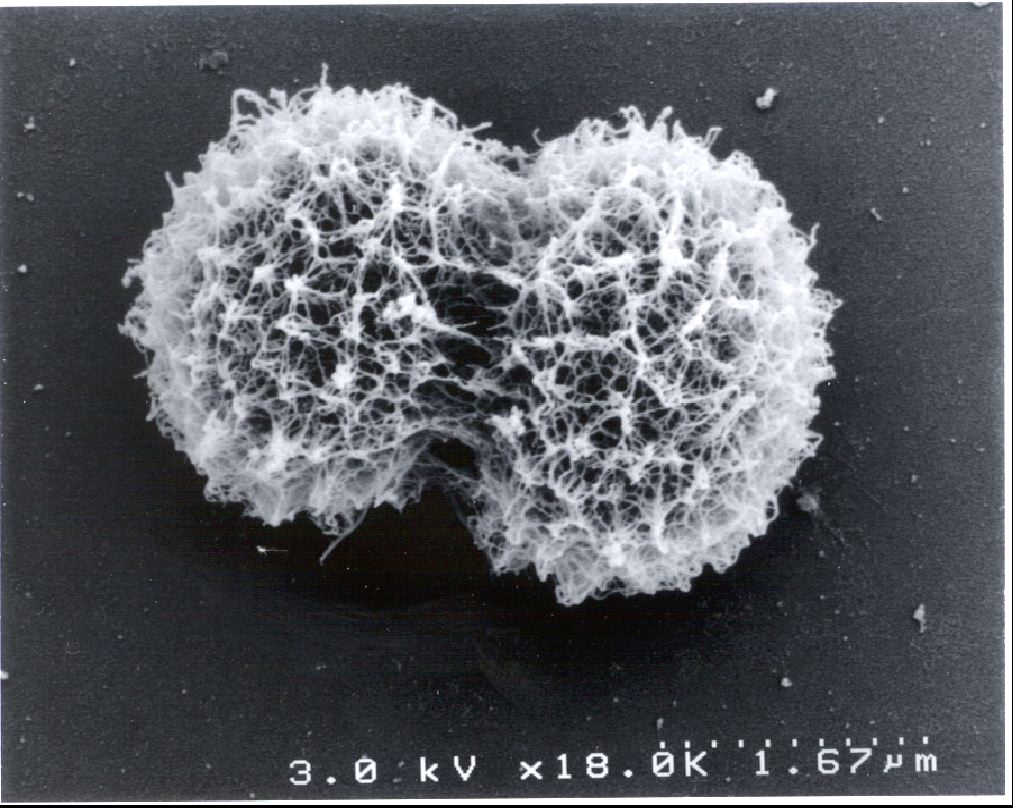| |
 PHOTOMICROGRAPH
of strain CJ2. Note coccoid shape of 2 dividing cells, rough surface
texture from extra-cellular polysaccharide, absence of flagella,
and size (1-2 um) visible in scanning electron microscopy PHOTOMICROGRAPH
of strain CJ2. Note coccoid shape of 2 dividing cells, rough surface
texture from extra-cellular polysaccharide, absence of flagella,
and size (1-2 um) visible in scanning electron microscopy
|
Polaromonas naphthalenivorans strain
CJ2, ATCC BAA-779; DSM 15660 is shown to be responsible for metabolizing
naphthalene in situ, in sediment in a contaminated field site.
Organic environmental
pollutants are among the major concerns of the Department of Energy.
Of crucial significance to DOE is understanding the ecological
fitness traits of microorganisms that allow them to survive in
field sites and be active in situ. One class of important contaminants
is polycyclic aromatic hydrocarbons (PAHs), whose simplest member
is naphthalene.
PAHs are proven
carcinogens commonly found at DOE's energy production sites. Polaromonas
naphthalenivorans strain CJ2 grows on naphthalene, favors in situ
temperatures, accelerates naphthalene metabolism when inoculated into
the sediment microbial community, and is host to a naphthalene dioxygenase
allele previously shown to be expressed (as mRNA) in situ in sediment.
Strain CJ2
features taxonomic and physiological novelty and synergistic
links to other bacteria. To our knowledge, only one member of
the Comamonadaceae has been sequenced to date. This is "beta-bacterium
strain JS666" that grows on the chlorinated pollutant cis -dichloroethene
. The 16S rRNA gene sequences of strain CJ2, strain JS666, and Polaromonas
vacuolata indicate close evolutionary relatedness. But phenotypic
traits (motility, colony type on plates, temperature optima,
catabolic breadth, ability to accumulate physiological carbon
storage reserves, etc.) indicate immense diversity. Strain CJ2's
naphthalene catabolic gene cluster is an interesting variant
on the nag catabolic cluster recently described in the
beta proteobacterioum, Ralstonia sp. strain U2. We seek
to discover if this catabolic gene cluster is the cause of strain
CJ2's ecological success. Alternatively, genetic features unlinked
to catabolism may be essential for ecological success. An underlying
motivation for obtaining genomic sequence of strain CJ2 is to
weave together a comparative scheme of evolutionary relatedness,
physiological versatility, ecological fitness, and horizontal
gene transfer.
REFERENCES
C. Jeon , W. Park,
P. Padmanabhan, C. DeRito, J. R. Snape, E. L. Madsen. 2003. Discovery
of a novel bacterium, with distinctive dioxygenase, that is responsible
for in situ biodegradation in contaminated sediment. Proc. Nat. Acad.
Sci. USA 100:13591-13596.
Jeon, C.-O.,W. Park,
W.C. Ghiorse, and E. L. Madsen. 2004. Polaromonas naphthalonivorans gen.
nov., sp. nov., a naphthalene-degrading bacterium from naphthalene-contaminated
sediment. Intl. J. Syst. Evol. Microbiol. 54: 93-97.
|

 PHOTOMICROGRAPH
of strain CJ2. Note coccoid shape of 2 dividing cells, rough surface
texture from extra-cellular polysaccharide, absence of flagella,
and size (1-2 um) visible in scanning electron microscopy
PHOTOMICROGRAPH
of strain CJ2. Note coccoid shape of 2 dividing cells, rough surface
texture from extra-cellular polysaccharide, absence of flagella,
and size (1-2 um) visible in scanning electron microscopy